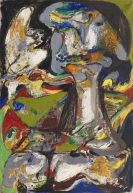
Corneille
1922 Lüttich
Corneille was born on July 3, 1922 in Lüttich as Cornelis Guillaume van Beverloo. He was one of the founders of the international artist group Cobra. From 1940-43, the Belgian artist of Dutch descent took drawing lessons at the academy in Amsterdam. He continued his studies autodidactically, especially following his role models of Henri Matisse and Pablo Picasso, as well as Édouard Pignon in a later period.
After a brief phase of orientation upon Joan Miró und Paul Klee’s cubism, Corneille found his own lyrical use of form. Together with Karel Appel and Constant, he founded a Dutch experimental group, a European parallel to American abstract expressionism.
The group established itself on November 8, 1948 as CoBrA. Its manifesto was: "A painting is not a structure of colors and lines, but an animal, a night, a scream, a person, or everything together. It is the objective, abstracting spirit of the bourgeois world that has reduced the product of painting to its means of production". Every creation must "emerge from the active observation of every form of nature and art". "After a period in which it exhibited NOTHING, art must now enter into a phase in which it exhibits EVERYTHING".
In 1949, Corneille exhibited for the first time in Paris. Starting in 1953, he learned etching skills from Stanley William Hayter in Paris. In 1954, he worked in ceramics with Tullio Spartaco Mazzotti and participated in the Venice Biennial later that year.
He received the Guggenheim Prize for Holland two years later. On his numerous foreign trips to North Africa, South America, and the U.S.A., Corneille always gains new inspiration for color combinations and his own vocabulary of form.
The artist primarily lives and works in Paris.

Would you like to sell a work by Corneille?
Infos for seller






